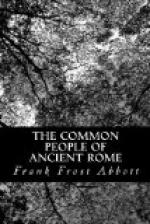If we look at the growth of private munificence under the Republic, we shall see that citizens showed their generosity particularly in the construction of public buildings, partly or entirely at their own expense. In this way some of the basilicas in Rome and elsewhere which served as courts of justice and halls of exchange were constructed. The great Basilica AEmilia, for instance, whose remains may be seen in the Forum to-day, was constructed by an AEmilius in the second century before our era, and was accepted as a charge by his descendants to be kept in condition and improved at the expense of the AEmilian family. Under somewhat similar conditions Pompey built the great theatre which bore his name, the first permanent theatre to be built in Rome, and always considered one of the wonders of the city. The cost of this structure was probably covered by the treasure which he brought back from his campaigns in the East. In using the spoils of a successful war to construct buildings or memorials in Rome, he was following the example of Mummius, the conqueror of Corinth, and other great generals who had preceded him. The purely philanthropic motive does not bulk largely in these gifts to the citizens, because the people whose armies had won the victories were part owners at least of the spoils, and because the victorious leader who built the structure was actuated more by the hope of transmitting the memory of his achievements to posterity in some conspicuous and imperishable monument than by a desire to benefit his fellow citizens.
These two motives, the one egoistic and the other altruistic, actuated all the Roman emperors in varying degrees. The activity of Augustus in such matters comes out clearly in the record of his reign, which he has left us in his own words. This remarkable bit of autobiography, known as the “Deeds of the Deified Augustus,” the Emperor had engraved on bronze tablets, placed in front of his mausoleum. The original has disappeared, but fortunately a copy of it has been found on the walls of a ruined temple at Ancyra, in Asia Minor, and furnishes us abundant proof of the great improvements which he made in the city of Rome. We are told in it that from booty he paid for the construction of the Forum of Augustus, which was some four hundred feet long, three hundred wide, and was surrounded by a wall one hundred and twenty feet high, covered on the inside with marble and stucco. Enclosed within it and built with funds coming from the same source was the magnificent temple of Mars the Avenger, which had as its principal trophies the Roman standards recovered from the Parthians. This forum and temple are only two items in the long list of public improvements which Augustus records in his imperial epitaph, for, as he proudly writes: “In my sixth consulship, acting under a decree of the senate, I restored eighty-two temples in the city, neglecting no temple which needed repair at the time.” Besides the temples, he mentions a large number of theatres, porticos, basilicas, aqueducts, roads, and bridges which he built in Rome or in Italy outside the city.




